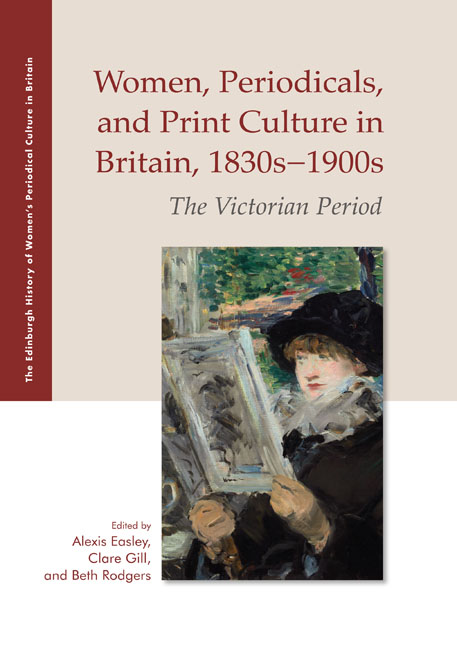Book contents
- Frontmatter
- Contents
- List of Illustrations
- Acknowledgments
- Introduction: Women, Periodicals, and Print Culture in the Victorian Period
- Part I (Re)Imagining Domestic Life
- Part II Constructing Modern Girls and Young Women
- Part III Women and Visual Culture
- Part IV Making Space for Women
- Making Space for Women: Introduction
- 18 Women Journalists and Periodical Spaces
- 19 Making Space for Women's Work in the Leisure Hour: From Variety to ‘Verity’
- 20 Avatars, Pseudonyms, and the Regulation of Affect: Performing and Occluding Gender in the Pall Mall Gazette
- 21 Gender, Anonymity, and Humour in Women's Writing for Punch
- 22 Making Space for Women: The Labour Leader, the Clarion, and the Women's Column
- 23 By the Fireside: Margaret Oliphant's Armchair Commentaries
- Part V Constructing Women Readers and Writers
- Part VI Intervening in Political Debates
- Notes on Contributors
- Index
- Plate section
22 - Making Space for Women: The Labour Leader, the Clarion, and the Women's Column
from Part IV - Making Space for Women
Published online by Cambridge University Press: 25 October 2019
- Frontmatter
- Contents
- List of Illustrations
- Acknowledgments
- Introduction: Women, Periodicals, and Print Culture in the Victorian Period
- Part I (Re)Imagining Domestic Life
- Part II Constructing Modern Girls and Young Women
- Part III Women and Visual Culture
- Part IV Making Space for Women
- Making Space for Women: Introduction
- 18 Women Journalists and Periodical Spaces
- 19 Making Space for Women's Work in the Leisure Hour: From Variety to ‘Verity’
- 20 Avatars, Pseudonyms, and the Regulation of Affect: Performing and Occluding Gender in the Pall Mall Gazette
- 21 Gender, Anonymity, and Humour in Women's Writing for Punch
- 22 Making Space for Women: The Labour Leader, the Clarion, and the Women's Column
- 23 By the Fireside: Margaret Oliphant's Armchair Commentaries
- Part V Constructing Women Readers and Writers
- Part VI Intervening in Political Debates
- Notes on Contributors
- Index
- Plate section
Summary
THE BRITISH SOCIALIST MOVEMENT, as Jack Mitchell states, ‘laid tremendous weight on the word’ (1987: 51) and took full advantage of the late nineteenthcentury cheap periodical press. The mid-century abolition of newspaper taxes and later improvements in mechanical printing had lowered the cost of production and so each new socialist group would almost inevitably be heralded by the publication of its own periodical. The Social Democratic Federation's (SDF) Justice was the first British socialist periodical, founded in 1884, and was followed by the Socialist League's Commonweal in 1885. A plethora of national and regional socialist periodicals sprang into being to promote each individual group's ideas of how the socialist dawn might be achieved. The Clarion (1891–1935) first appeared in this lively and combative market in 1891 and the Labour Leader (1894–1922), revived from an earlier iteration, began production in 1894.
The Clarion and the Labour Leader were both controlled by charismatic socialists: former soldier Robert Blatchford (1851–1943) edited the Clarion and former miner James Keir Hardie (1856–1915) edited the Labour Leader. Blatchford and Hardie took an intuitive and ethical route to their socialism (as opposed to the Marxist revolution pursued by the SDF and Socialist League), and both men had championed the idea of founding a working-class political party. Nevertheless, there were significant differences in their approach to socialism and its dissemination. Despite his early involvement with labour politics, Blatchford soon after rejected the political route to change, arguing in his autobiography that his desire was to ‘Convince the people and never mind parties’ (1931: xiii), while Hardie worked for the formation of both the Independent Labour Party (ILP) in 1893 and the Labour Representation Committee in 1900 (renamed the Labour Party in 1906). The whisky-loving Blatchford believed that working-class people needed entertainment as well as politics in their dreary lives, stating in the first issue of the Clarion that ‘truth may lie under a smile as well as under a frown’ (12 Dec 1891: 4), while the teetotal Hardie criticised the Clarion group for having ‘almost totally destroyed [the socialist movement] by a spirit of irresponsible levity’ (Thompson 1951: 127).
- Type
- Chapter
- Information
- Women, Periodicals and Print Culture in Britain, 1830s–1900sThe Victorian Period, pp. 365 - 378Publisher: Edinburgh University PressPrint publication year: 2019

